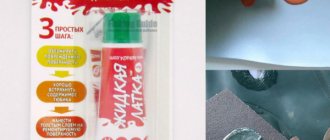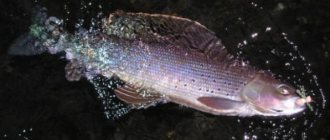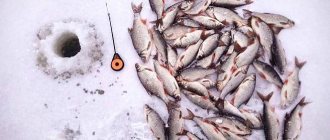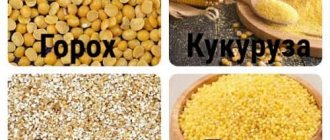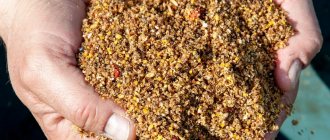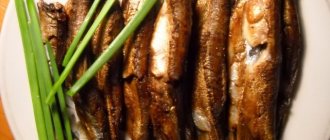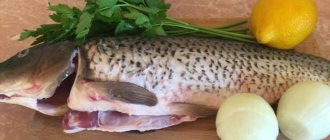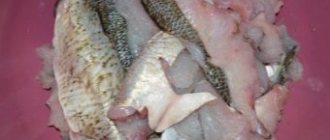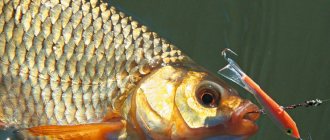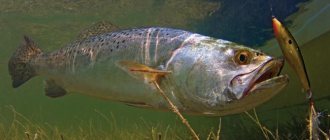Your own bait for fishing
In order to introduce you to the “bait business”, below I will give the most common methods of preparing fishing bait mixtures, which I use myself.
Methods for preparing bait for fishing from different products at home
For me, bottom or float fishing begins when I come to the kitchen from the grocery store. It is near the stove that the basis for successful fishing is laid, here plans for tomorrow are prepared, based on which fishing bait is made.
What it will be like: soft or hard, dense or crumbly, what components will be present are dictated by the fishing conditions and the object of the hunt, that is, fish. Therefore, standing at the meat grinder or at the stove, I “scroll” in my head all possible scenarios for the development of events on tomorrow’s fishing and “adjust” the prepared food to suit them.
It seems like a simple matter - bait. If you throw something edible into the water, the fish will gather closer to the fishing spot and begin to bite. Maybe in the old days, when there was enough fish, they did this. Today, the situation is different: the number of fish has decreased, and the fish have become wiser and become capricious. She is not now rushing headlong into table scraps and waste from the food industry. Give her high-quality, properly prepared products, and even presented correctly - so our fishermen sweat in the kitchen no worse than their wives and then think through the strategy and tactics of feeding. But the fish still regularly ignores our efforts. And the variety of modern industrial fishing baits and the advertising that accompanies them can generally confuse the fisherman. Through trial and error, I came to three main points that relate to complementary feeding.
Firstly: use only a proven composition and feed according to proven tactics (this does not mean that I always feed with the same bait and always the same: for different fish and different conditions - different mixtures and different tactics).
Secondly: experiment only when proven bait and techniques do not help. I think that thoughtless improvisation with bait is fraught with lack of bite or “eating” on small things, which is no better.
And most importantly: do not trust any “lures” of bait.
Bait recipes for fishing
When you have already figured out what ingredients can be used for bait and what role each of them will play, it’s time to familiarize yourself with bait recipes that work great when fishing. There is nothing complicated in preparing them, the costs are minimal, and the volume of bait will be exactly what you want. So let's get started.
Bait for fishing recipe No. 1 + video
Each bait, made more or less correctly, has the right to exist. But there are bait recipes that have advantages over others. For example, ease of preparation, low cost, ease of use, effectiveness. This recipe, which you are about to learn, contains all these advantages. This bait is perfect for putting into feeders or feeding the fishing point.
The bait consists of only 2 ingredients:
- millet;
- fried ground flour.
Millet can be bought at any grocery store, and ground fried flour can be bought at the market. Very cheap and effective. And the most important thing is that you can make a lot of such bait by spending the same amount as a package of purchased bait costs, which will be weaker both in efficiency and in volume. In addition, not every purchased bait is of high quality and sometimes it happens that it is completely unsuitable for filling feeder feeders, although it was bought specifically for this purpose.
Cooking method . Place a pan of water on the fire. We wait until it boils and pour in the millet. Millet must be poured in 2 times less than the water poured. Two cans of water - one millet. The millet is cooked until the water has completely boiled away. Then turn off the heat and add flour to the still hot millet, stirring thoroughly. Add flour by eye; you need to achieve a very viscous consistency so that the bait looks like plasticine.
It is advisable to make bait the day before fishing. That is, if you go fishing in the morning, then prepare your bait in the evening. By morning, its consistency may change and it will be necessary to add water or flour to it to achieve exactly the consistency that is needed. Although this can be done without any problems directly while fishing.
Millet can also be sugared. This sweetness will help attract fish from afar. You can watch more details about preparing this bait in this video:
Bait for fishing recipe No. 2 + video
This recipe will be more complicated and consists of more ingredients. Just like the first recipe, it is universal and suitable for feeding any fish. A very good, effective bait recipe that will not only attract fish from distant points in the reservoir, but will also keep it in the baited area for a long time.
For preparation we will need the following ingredients:
- millet - 300 gr;
- rice - 300 gr;
- breadcrumbs - by eye, to achieve the desired viscosity;
- cinnamon - 1 teaspoon;
- vanillin - 1.5 packs;
- sugar - 150 grams;
- salt - 1 teaspoon;
- powdered milk - 1-3 tablespoons;
- raw chicken eggs - 2 pcs.
Cooking . You can prepare this bait for fish either in a saucepan on the stove or in a double boiler. Prepare this way: pour 1 liter of water into a saucepan, immediately add dry milk, vanillin, cinnamon, sugar, salt and mix everything thoroughly. Now you can pour millet and rice into our “broth”. Stir and cook for about 40 minutes, or until the water boils away. While the bait is cooking, you can beat the chicken eggs, and add them to the porridge about 15 minutes before it is ready and mix well.
The porridge is ready and you can add breadcrumbs. Rusks, as already written, are needed to give the porridge the desired consistency. The porridge itself should turn out dry and crumbly, but at the same time mold well into lumps and get clogged into the spring (feeder). More details in the following video:
Please rate the article:
Special thanks to those who shared on their favorite social network
Porridge . In our country, until recently, bait mostly consisted of porridge or boiled grain, even for athletes in the early 1990s. Before the competition, we cooked porridge for bait. It must be said that it was basically millet porridge, initially small and crumbly, the main thing was to cook it correctly. There are two cooking options. The first is the usual one, when 1 kg of cereal is poured into 1.8 liters of water and boiled until the water boils away, then it is left to steam.
Almost win-win and easiest to implement options: either use ready-made branded flavors for a specific fish or for fishing conditions, or experiment with fruit and berry flavors, which, as a rule, go well with a homemade bait base. The only difficulty is insufficient statistics, because you have to experiment alone.
Other components. Previously, various natural flavors were often used in groundbait (from vanilla and cinnamon to anise), oatmeal, powdered or concentrated milk, etc. Now, in my opinion, their use is unjustified, since it is either too expensive, or they have full-fledged and inexpensive substitutes (for example, artificial flavors), or some components are simply no longer produced (oatmeal).
The question is often asked: is there a bite activator for predators? For some fish species, such as catfish, the sense of smell plays an important role in finding prey. Experienced cat fishermen know that the best activator of food activity for catfish is chicken liver. Bait made from fresh chicken liver or a feeder with the same bait, slowly releasing chicken blood in the water, are excellent activators of catfish biting.
crumbling
I use it in both float and bottom bait, naturally not in its pure form. Inexpensive industrial bait is also suitable as a crumbly mixture, the main requirement for which is a stable, but not pungent odor. The mixture may smell like a flavor (vanilla, cinnamon, strawberry, etc.), or it may have a neutral odor, reminiscent of aquarium food. When buying a package of fishing bait, I always sniff to see if it is musty.
Next, I dilute this mixture to increase its quantity and reduce the overly persistent odor. For this I use breadcrumbs, semolina and seeds.
By the way, you can make bait from these components from scratch, which is what I do when I can’t buy a store-bought mixture. I twist the crackers in a meat grinder from pre-dried pieces of loaf.
I have developed a good habit of periodically setting aside a loaf of bread to dry so that I have a reserve supply of crackers. If that doesn't work, you have to use the oven. Along with the breadcrumbs, I also twist the seeds bought at the kiosk (I take the ones I eat myself). Ground seeds have a pleasant, unobtrusive odor, which is great for attracting fish. I try to achieve a crackers-seeds-semolina ratio of 1.5:1:1. I dilute the purchased bait with this mixture approximately 1:1.
Such crumbling performs its main function - it attracts fish with its smell and creates a cloudy suspension, which the fish cannot get enough of, which means its food instincts are excited and it attacks our bait.
Roach baits
Roach is a fish that is quite versatile and does not require bait, so both plant and animal baits can be used as bait.
Animal baits work well in spring, autumn and winter; plant baits are practically useless during this period. In summer, plant baits work well.
The following can be used as animal baits:
- dung and other worms;
- maggot;
- bloodworm;
- ant eggs, just don’t ruin the anthills, look under boards, logs and similar places that you can then close back;
- zoophobos or mealworm;
- bark beetle larvae;
- caddisfly larvae;
- lard with garlic.
The following work well as plant baits:
- bread;
- dough;
- pearl barley;
- corn;
- sometimes peas or chickpeas;
- hemp seeds.
Porridge
The smell is a smell, but a fish, especially a large one, also needs to feel the taste of food, otherwise it will quickly figure out the trick and leave, and at best, there will be only a small thing left to peck. This is exactly what porridge is for. In addition, porridge further dilutes the mixture, thereby reducing its cost. And porridge also has its own alluring smell. It also gives fishing bait viscosity and weight, which is often necessary for baiting.
The consistency of the porridge can be viscous or crumbly. The latter, in addition to cereals, includes peas and corn. I usually use crumbly porridge when fishing for crucian carp. I throw it in bulk, or if I need to throw it further away, I mix it with the ground, forming balls.
When river bottom fishing I do not use crumbly porridge, as it is washed out of the feeder too quickly. The main element of such bait is mass starting feeding when catching relatively large fish. Crumbly porridge mixed with a dry mixture attracts fish well, slightly saturates it, preventing it from leaving. This is also an excellent option for attachment.
For porridge I use pearl barley, millet, rice, and have also tried canned corn. But more often I cook a viscous mass (mainly from millet, rice or Hercules). I also mix this with dry food. This makes an excellent fishing bait for the feeder. It is also suitable for float fishing during initial feeding. For float crumbly bait, I mainly use sand or mole soil, mixed with dry food in a 3:1 ratio. For abundant feeding, I don’t use sand; I try to take blacker soil, clay, or swampy peat mass. Having mixed this soil with bait, I make balls (for flow) or cakes (for standing water). I also had to feed them with a mixture of food and sludge. Although such bait did not fly far, it created a strong turbidity, and the fish then bit perfectly.
Bread
It happens that during the fishing process you realize that the bait lacks viscosity. You can get out of the situation with a crust of bread or a couple of sandwiches. We crumble the bread into the bait, mix it, and good viscosity of the food is ensured. It also happens: the opportunity to go fishing falls out of the blue, and there is no time to cook porridge. In this case, I do this: I buy a loaf of bread and crumble it along with the crumbly mixture at the pond. All that remains is to add the required amount of water. By the way, you need to moisten the food a little at a time, constantly stirring, avoiding oversaturation with water. In my opinion, the bait should be moistened immediately before fishing, using water from a reservoir, and not from the tap. These points apply not only to “bread” bait, but also to other fishing baits.
In conclusion about bread, I will note: if you compare black bread and white bread, then their properties are different. Black is more viscous and has a strong odor, while white creates more turbidity and is better visible on a dark bottom.
Millet
I love this cereal because it is versatile and affordable. The versatility of millet lies in the fact that if you slightly undercook it and dry it thoroughly, it will become crumbly, almost airy. By mixing it with a dry composition, we get the ideal bait for float fishing for roach, small bream, rudd and other “sports” fish. Normally cooked millet, mixed with the same dry composition and crushed to good viscosity, becomes formidable ammunition for feeding artillery.
And its main trump card: it sticks well to itself the crumbly mixture, which creates turbidity, and does not form into lumps, evenly covering the bottom in the place of fishing when feeding. And of course, pearl barley is famous for its wonderful smell that intoxicates fish. In addition, this bait is good for feeding when fishing with a float rod.
What is Super Bite bait?
Not so long ago, baits were clearly distributed according to their sphere of influence. That is, one attracted fish with light, another with sound, and the third emitted vibrations. Super bite is a special type of bait that affects all receptors at once: hearing, vision, smell, sensitivity.
This is a specially designed device that effectively lures fish to the fishing spot. You can use super bite in reservoirs with salt or fresh water, in lakes or rivers with fast currents.
It works this way. Super bite sends out special low-frequency emissions that attract any fish within a radius of forty meters. In order for it to start working, you don’t need to do practically anything; after you put it in the water, it will start working on its own.
Externally, this device resembles a red cylinder. There are covers at the top and bottom of the housing. On the top of the cover there are electronic contacts, one has a positive charge and the other has a negative charge. The surface of the super bite consists of a light-emitting element. A special ring helps this device to be aimed at the fishing rod.
Peculiarities
After this bait falls into the water, it immediately turns on, begins to glow, emit sound waves, and vibrate. It is she who influences the fish, using all its analyzers.
The peculiarity of the bait is that it is capable of influencing all fish receptors at once with the help of:
- Sveta. Immediately after entering the water, the super bite begins to glow and flash. Particularly effective during night fishing.
- Sound. Produces low-frequency sound waves that can travel almost one kilometer. The operating efficiency does not decrease even in muddy water.
- Vibrations. They affect the entire body of the fish, especially the sensitive sides
After the super bite is pulled out of the water and wiped off, it stops working.
Advantages
Super bite has several advantages, which explain its popularity among fishermen:
- Impact on all fish receptors at once
- The range is huge, almost one kilometer
- There is no risk of “overfeeding” the fish
- Easy to use and does not require special knowledge
- Versatility, it is suitable for fishing at any time of the year in any body of water
- Powered by a battery that can be charged from the mains
- Effective at any temperature
Rice
An excellent grain for bait, but due to its rather high price I rarely use it. In principle, rice resembles millet in its properties. But this cereal has one advantage - its color. These white grains are very reminiscent of the same maggot. And on a dark bottom, white rice looks contrasting, allowing the fish to be guided not only by smell, but also by sight when feeding.
So, the choice of cereal depends not only on its properties, but also on the price. I don’t recommend buying cereals of dubious quality; it’s better to take the one you want for your table.
Animal components
In most cases, fish value “live” food more highly than plant food. But, alas, not everyone can afford to feed their fish only worms and bloodworms. Therefore, it is worth adding them to our traditional fishing bait, at least whenever possible. I usually add chopped worms and crushed bloodworms. I don’t add moving organisms for the reason that they can disrupt the consistency of the mixture; it’s better if they attract fish with their smell and taste. I almost always add maggot pupae left over from previous fishing trips. If I find a box left on the shore when the smell spreads downstream and active fish are able to rise to the bait. In this situation, you can add a little sand to help wash away the feed. In other cases, I roll fishing bait into clay or earthen balls. For feeder fishing, you also need viscous food, but instead of soil I use porridge or bread. A more complicated situation arises if you need to use crumbly porridge. Usually in such cases the food is thrown upstream so that it sinks to the bottom at the fishing site. I use this technique: I mix crumbly porridge with soil and form balls. When such a ball falls into the water, it will quickly sink, disintegrating further in the water column. As a result, the bottom at the fishing site is covered with a uniform layer of porridge.
Main components
The secrets of fishing lie not only in good bait, but in some cases it is precisely this that can provide an excellent catch. In order to make a high-quality and effective bait, you need to take a closer look at the components included in its composition:
- Crackers. Made from white bread or biscuit crumbs, they provide the necessary stickiness.
- Bran. Another component based on white bread. Its task is to make the bait balls dissolve in the water.
- Sunflower cake. It has a large amount of proteins and also helps to loosen the composition.
- Various porridges (the most popular is millet). A fairly common solution for Russian fishermen. To prepare this kind of bait, you need to boil the cereals in water (1/1.8) until it completely boils away. Then the porridge is left to steam until the end.
- Flavors. They are a specific way to attract fish. They should be added to the homemade mixture by eye, in small quantities. Your task is that the aroma should be present, but be very weak, almost imperceptible.
Briefly about feeding tactics
I won’t describe how to feed: “a lot at once” or “a little bit at a time” - it all depends on the fishing conditions, the type of fish, the weather, the time of year and day, and many other factors. We will describe all this in other articles, in detail for each type of fishing and fish (look at the top, or in the site menu). I will only share some small tactical tricks. Sometimes a dry crumbly mixture attracts a lot of little things that are difficult to get rid of. In this case, I feed them with one crumbly porridge.
Many people like to fish with a float in a sportive way, regularly throwing crumbly bait. I use this technique: I accompany each cast of the tackle by tossing food. Then I stop throwing food, pausing for about 15 minutes. It is at this time that bites occur from larger fish, which are frightened by the noise of the bait, but then still approach the mud.
